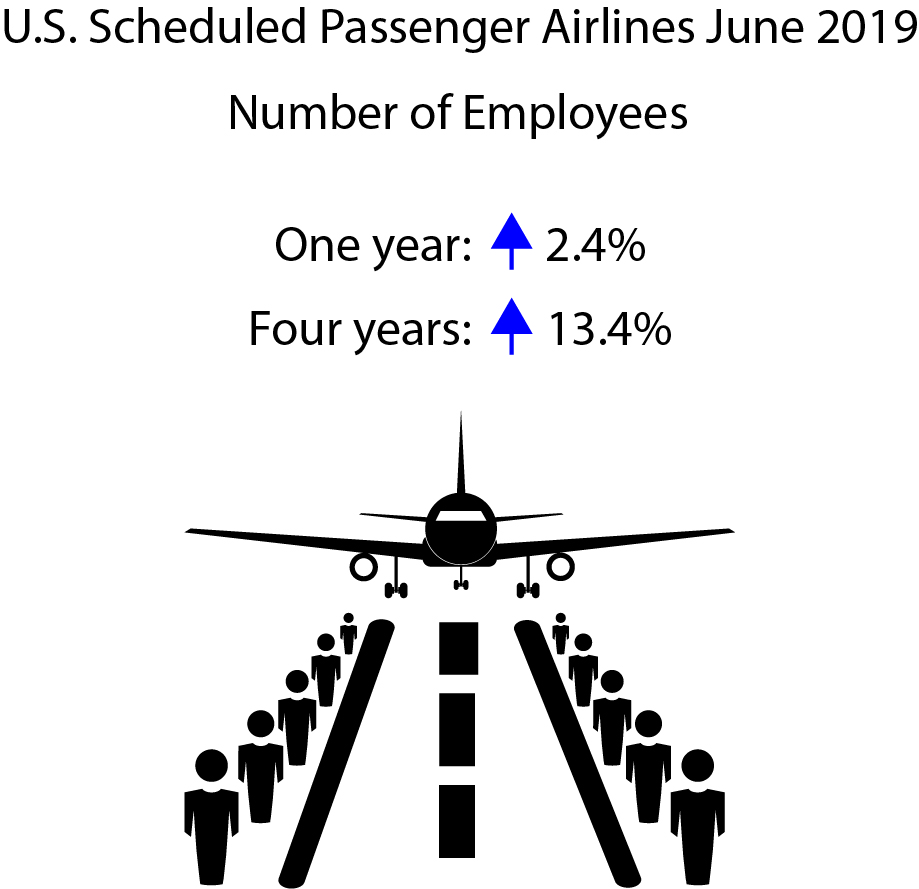June 2019 U.S. Passenger Airline Employment Data

The 21 U.S. scheduled passenger airlines employed 2.4% more workers in June 2019 than in June 2018:
- June’s 449,985 full-time equivalents (FTE) was the highest employment total for any month since March 2003 (458,598 FTEs).
- June was the 68th consecutive month that U.S. scheduled passenger airline FTEs exceeded the same month of the previous year.
Employees at U.S. Scheduled Passenger Airlines Month of June, 1990-2019, (Full-Time Equivalents)
| June FTEs in thousands (000) | 1 | |
|---|---|---|
| 1990 | 460.9 | 2 |
| 1991 | 447.9 | 3 |
| 1992 | 451.3 | 4 |
| 1993 | 445.8 | 5 |
| 1994 | 433.4 | 6 |
| 1995 | 429.0 | 7 |
| 1996 | 441.3 | 8 |
| 1997 | 452.6 | 9 |
| 1998 | 473.1 | 10 |
| 1999 | 498.1 | 11 |
| 2000 | 521.4 | 12 |
| 2001 | 545.9 | 13 |
| 2002 | 472.4 | 14 |
| 2003 | 440.0 | 15 |
| 2004 | 441.0 | 16 |
| 2005 | 423.3 | 17 |
| 2006 | 403.3 | 18 |
| 2007 | 413.7 | 19 |
| 2008 | 414.2 | 20 |
| 2009 | 387.7 | 21 |
| 2010 | 378.9 | 22 |
| 2011 | 387.1 | 23 |
| 2012 | 388.3 | 24 |
| 2013 | 381.7 | 25 |
| 2014 | 385.2 | 26 |
| 2015 | 397.0 | 27 |
| 2016 | 412.3 | 28 |
| 2017 | 427.8 | 29 |
| 2018 | 439.4 | 30 |
| 2019 | 450.0 | 31 |
| 32 |
FTE calculations count two part-time employees as one full-time employee.
Bureau of Transportation Statistics
U.S. airline employment reports are filed monthly with the Bureau of Transportation Statistics. See the tables that accompany this release on the BTS website for detailed data since 2015 (Tables 1-15) and industry summary data since 1990.
All 21 scheduled service passenger airlines
- 449,985 FTEs
- Up 2.4% (10,563 FTEs) over June 2018 (439,422 FTEs)
- Up 13.4% (53,012 FTEs) over June 2015 (396,973 FTEs)
Four network airlines
- 289,443 FTEs, 64.3% of total scheduled passenger airline FTEs
- Up 1.0% (2,773 FTEs) over June 2018 (286,670 FTEs)
- Up 9.0% (23,957 FTEs) over June 2015 (265,486 FTEs)
Network airlines operate a significant portion of their flights using at least one hub where connections are made for flights to down-line destinations or spoke cities. Note that beginning with January 2018 data, Virgin America’s numbers are included with Alaska Airlines in the network category.
Five low-cost airlines
- 95,668 FTEs, 21.3% of total scheduled passenger airline FTEs
- Up 5.1% (4,630 FTEs) over June 2018 (91,038 FTEs)
- Up 28.3% (21,076 FTEs) over June 2015 (74,592 FTEs)
Low-cost airlines operate under a low-cost business model, with infrastructure and aircraft operating costs below the overall industry average.
10 regional airlines
- 56,696 FTEs, 12.6% of total scheduled passenger airline FTEs
- Up 5.3% (2,838 FTEs) over June 2018 (53,858 FTEs)
- Up 12.6% (6,323 FTEs) over June 2015 (50,373 FTEs)
Regional carriers typically provide service from small cities, using primarily regional jets to support the network carriers’ hub and spoke systems.
Top Employers by Group
- Network: American 102,076 FTEs
- Low-Cost: Southwest 59,793 FTEs
- Regional: SkyWest 14,900 FTEs
Two other airlines
Other carriers generally operate within specific niche markets. They are: Hawaiian Airlines and Sun Country Airlines.
Reporting Notes
Airlines that operate at least one aircraft that has more than 60 seats or the capacity to carry a payload of passengers, cargo and fuel weighing more than 18,000 pounds must report monthly employment statistics.
Data are compiled from monthly reports filed with BTS by commercial air carriers as of Aug 7. Additional airline employment data and previous releases can be found on the BTS website. BTS has scheduled release of July passenger airline employment data for Sept. 17.
